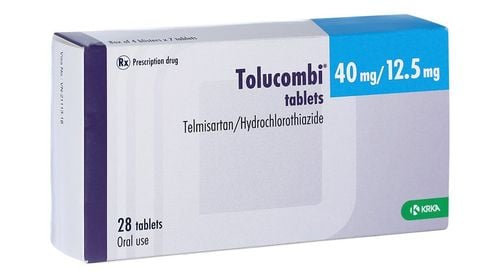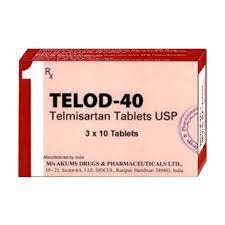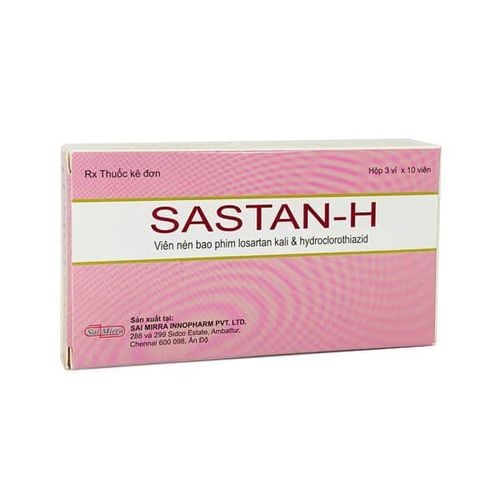This is an automatically translated article.
Cilzec Plus is a combination of Telmisartan and Hydrochlorothiazide for the treatment of essential hypertension in adults. Complying with indications, the dose of Cilzec Plus will help patients improve treatment effectiveness and avoid unwanted side effects.1. What is Cilzec Plus?
Cilzec Plus contains the main ingredients Telmisartan and Hydrochlorothiazide, which are used to treat high blood pressure. The drug is available in the form of uncoated tablets.
The drug is not indicated in the initial treatment.
2. How to use, dosage of Cilzec Plus
2.1. How to take Cilzec Plus Take Cilzec Plus 1 time per day, regardless of meals because food only slightly reduces the bioavailability of the drug.
The information provided is not a substitute for medical professional advice. Always consult your doctor or pharmacist before deciding to take a medication.
2.2. Dosage of Cilzec Plus For adults with normal liver and kidney function:
Take 1-2 tablets per day. Before increasing the dose, it should be noted that the maximum antihypertensive effect is usually achieved after 4 to 8 weeks of treatment. Patients with renal impairment:
Due to the hydrochlorothiazide component, the drug is not contraindicated in patients with severe renal impairment (creatinine clearance ≤ 30ml/min). Loop diuretics are preferred over thiazides in these patients. Experience is limited in patients with moderate to mild renal impairment, but there are no known renal side effects and no dose adjustment is required. Renal function should be monitored periodically. Patients with hepatic impairment:
In patients with mild or moderate hepatic impairment, the dose should not exceed 1 tablet (telmisartan 40 mg/ hydrochlorothiazide 12.5 mg) once daily. This drug is not indicated in patients with severe hepatic impairment. Thiazides should be used with caution in patients with impaired liver function. Elderly patients:
No dose adjustment required.
3. Contraindications of the drug Cilzec Plus
Cilzec Plus is contraindicated in the following cases:
Patients with hypersensitivity to any ingredient of the drug. 2nd and 3rd trimesters of pregnancy, breastfeeding women. Disorders that cause biliary obstruction. Severe liver failure. Gout, hyperuricemia, anuria, Addison's disease, hypercalcemia, severe liver and kidney failure.
4. Notes when using Cilzec Plus
Caution when administering the drug to the following subjects:
Effects of the drug on the fetus / neonate: Telmisartan acts directly on the renin angiotensin system which can cause damage, even death to the fetus. Neonates with a history of exposure to angiotensin II receptor antagonists in utero should be closely monitored for symptoms of hypotension, oliguria, and hyperkalemia. Thiazides cross the placenta and are present in umbilical cord blood. Therefore, there is a risk of jaundice and thrombocytopenia in the fetus and neonate. Hypotension in volume-depleted patients: Caution should be exercised when initiating antihypertensive therapy in patients in whom the renin-angiotensin system is activated, such as those with sodium or intravascular volume depletion. Hepatic impairment: Thiazide diuretics should be used with caution in patients with hepatic impairment or with advanced liver disease. Hypersensitivity Reactions: Hypersensitivity reactions may occur in patients with or without a history of allergy or bronchial asthma. Systemic lupus erythematosus: Thiazide diuretics may worsen or trigger systemic lupus erythematosus. Serum electrolytes: There have been no reports of discontinuation due to hypokalemia during treatment with telmisartan plus hydrochlorothiazde. Clinical signs of water and electrolyte imbalance should be monitored in patients treated with thiazides. Uremia may occur or gout appears in some patients receiving thiazide therapy. In patients with diabetes, it may be necessary to adjust the dose of insulin or oral hypoglycemic agents. Hyperglycaemia may occur with thiazide diuretics. The antihypertensive effect of the drug may be enhanced by its use in patients after sympathectomy. If renal failure develops, consideration should be given to discontinuing or continuing the diuretic. Impaired Hepatic Function: Since most of telmisartan is excreted in the bile, clearance is reduced in patients with biliary obstruction or impaired liver function. Cilzec Plus should be used with caution in these patients. Impaired renal function: The drug inhibits the renin - agiotensin - aldosterone system, so it may alter renal function in susceptible patients. Thiazides should be used with caution in patients with severe renal impairment. In patients with renal disease, thiazides may cause uremia and impaired renal function. Co-inhibitor of the renin - agiotensin - aldosterone system: Because the drug inhibits the renin - agiotensin - aldosterone system, cases of alteration in renal function (including acute renal failure) have been reported. Care should be taken and renal function should be closely monitored when co-inhibiting the renin-agiotensin-aldosterone system. Use in Children: Safety and efficacy in children have not been established. In the elderly: In general, there are no differences in the safety and efficacy of the drug in the elderly compared with the young. Reports of clinical experience suggest that there is a difference in response to the drug between the elderly and the young, but the possibility that the elderly may be more sensitive to the drug should not be excluded. The effects of the drug on the ability to drive and use machines have not been studied. However, when driving and operating machinery, it should be borne in mind that dizziness or drowsiness may occasionally occur while taking the drug. Because of the potential for adverse effects in the infant, a decision should be made whether to discontinue the drug or to discontinue breastfeeding, depending on the importance of the drug to the mother.
5. Side effects of the drug Cilzec Plus
5.1. Side effects of Telmisartan Adverse Drug Reaction (ADR) is usually mild and transient, rarely requiring discontinuation.
Uncommon:
Systemic: Fatigue, headache, excessive hypotension, dizziness and especially in patients with dehydration (such as patients on high doses of diuretics), limb edema, angioedema , sweating profusely and blurred vision. Central nervous system: Agitation, anxiety and dizziness. Gastrointestinal: Dry mouth, nausea, abdominal pain, acid reflux, indigestion, flatulence and loss of appetite, diarrhea. Urinary: Decreased kidney function, increased creatinine and blood urea, urinary tract infection. Respiratory: Pharyngitis, sinusitis, upper respiratory tract infection, flu-like symptoms (cough, congestion or earache, fever, nasal congestion, runny nose, sneezing, sore throat). Bones - joints: Back pain, pain and muscle spasms. Symptoms are similar to tendinitis. Metabolic: Hyperkalemia. Rare:
Body as a whole: Angioedema. Eyes: Visual disturbances. Cardiovascular: Tachycardia, excessive drop in blood pressure or syncope (common in hypovolemic or salt-depleted patients, treated with diuretics, especially in the standing position). Gastrointestinal: Gastrointestinal bleeding. Skin: Skin rash, urticaria, itching. Liver: Increases liver enzymes. Blood: Decrease in hemoglobin, decrease in neutrophils. Metabolism: Hyperuricemia, hypercholesterolemia. 5.2. Side effects of Hydrochlorothiazide Common:
Body as a whole: Fatigue, dizziness, dizziness, headache. Circulatory: Orthostatic hypotension Metabolism: Hypokalemia, hyperuricemia, hyperglycemia, hyperlipidemia (at high doses). Uncommon:
Circulatory: Postural hypotension, arrhythmia. Gastrointestinal: Nausea, vomiting, loss of appetite, constipation, diarrhea, intestinal spasms. Skin: Urticaria, rash, photosensitivity. Metabolism: Hypomagnesaemia, hyponatremia, hypercalcemia, hypochloremic alkalosis, hypophosphataemia. Rare:
Systemic: Anaphylactic reactions, fever. Blood: Leukopenia, agranulocytosis, thrombocytopenia, aplastic anemia, hemolytic anemia. Neurological: Paresthesia, sleep disturbance, depression. Skin: Vasculitis, rash, purpura, erythema multiforme, dermatitis, toxic epidermal necrolysis, Stevens-Johnson syndrome. Liver: Hepatitis, intrahepatic cholestatic jaundice, pancreatitis. Respiratory: Dyspnea, pneumonia, pulmonary edema (anaphylactic reaction), respiratory failure. Genitourinary, urinary: Renal failure, interstitial nephritis, impotence. Eyes: Blurred vision. Hyperuricemia may trigger a potential gout attack. Orthostatic hypotension may occur with concomitant use of alcohol, anesthetics and sedation.
The article has provided information about the uses, doses and notes when using Cilzec Plus. To ensure safety for your health and maximize the effectiveness of your treatment, you need to take Cilzec Plus exactly as directed by your doctor.
Please dial HOTLINE for more information or register for an appointment HERE. Download MyVinmec app to make appointments faster and to manage your bookings easily.













